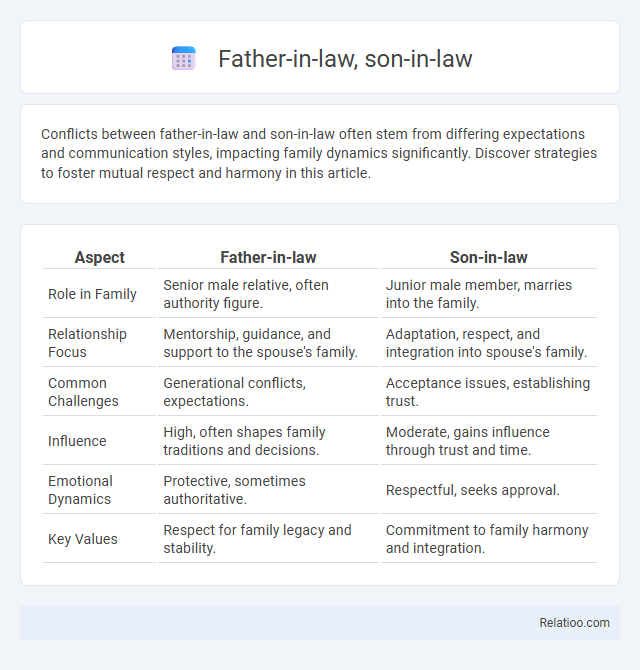Conflicts between father-in-law and son-in-law often stem from differing expectations and communication styles, impacting family dynamics significantly. Discover strategies to foster mutual respect and harmony in this article.
Table of Comparison
| Aspect | Father-in-law | Son-in-law |
|---|---|---|
| Role in Family | Senior male relative, often authority figure. | Junior male member, marries into the family. |
| Relationship Focus | Mentorship, guidance, and support to the spouse's family. | Adaptation, respect, and integration into spouse's family. |
| Common Challenges | Generational conflicts, expectations. | Acceptance issues, establishing trust. |
| Influence | High, often shapes family traditions and decisions. | Moderate, gains influence through trust and time. |
| Emotional Dynamics | Protective, sometimes authoritative. | Respectful, seeks approval. |
| Key Values | Respect for family legacy and stability. | Commitment to family harmony and integration. |
Understanding the Father-in-Law and Son-in-Law Dynamic
The father-in-law and son-in-law relationship often involves navigating complex family roles, balancing respect, and establishing boundaries to foster mutual understanding. Effective communication and empathy are crucial in strengthening this bond, as both parties adjust to their new familial positions. Recognizing cultural differences and individual personalities can further enhance harmony between father-in-law and son-in-law dynamics.
Key Differences Between Father-in-Law and Son-in-Law Roles
The key differences between father-in-law and son-in-law roles revolve around familial hierarchy and responsibilities. Your father-in-law typically holds a senior position within the family, offering guidance and support based on experience, while the son-in-law integrates into the family primarily through marriage, balancing respect with assimilation. Understanding these roles helps navigate family dynamics, preserving harmony and mutual respect.
Cultural Perspectives on In-Law Relationships
Father-in-law and son-in-law relationships are deeply influenced by cultural norms, often reflecting respect, hierarchy, and intergenerational roles that vary significantly across societies. In many Asian cultures, the father-in-law holds a position of authority and is central to family decision-making, while the son-in-law is expected to demonstrate filial piety and allegiance to the extended family. In-law dynamics in Western contexts tend to emphasize individual autonomy and mutual respect, with cultural variations shaping expectations and boundaries within these familial relationships.
Communication Styles: Bridging the Generation Gap
Father-in-law, son-in-law, and in-law relationships often involve distinct communication styles influenced by generational differences and cultural expectations. Fathers-in-law may prefer formal, respectful dialogue rooted in tradition, while sons-in-law tend to favor more casual and direct interactions, necessitating adaptive communication strategies. Bridging this generation gap requires active listening, empathy, and openness to diverse conversational norms to foster mutual understanding and strengthen family bonds.
Common Challenges in Father-in-Law vs Son-in-Law Relationships
Father-in-law and son-in-law relationships often face common challenges such as differing expectations, communication barriers, and generational gaps that can lead to misunderstandings and conflicts. Power dynamics and territorial feelings may cause tension, especially when boundaries related to family roles and involvement are unclear. Effective conflict resolution and mutual respect are essential to navigate and improve these complex familial interactions.
Building Mutual Respect and Trust
Building mutual respect and trust between a father-in-law, son-in-law, and other in-laws relies on open communication, empathy, and shared values. Establishing clear boundaries and recognizing each other's roles within the family enhances harmonious relationships. Commitment to resolving conflicts respectfully fosters lasting bonds and strengthens family unity.
Navigating Conflicts and Misunderstandings
Navigating conflicts between a father-in-law, son-in-law, and other in-laws requires clear communication and setting respectful boundaries to foster mutual understanding. You can reduce misunderstandings by actively listening and acknowledging each party's perspective while maintaining empathy. Establishing open dialogue helps create a cooperative family dynamic, easing tension and promoting harmony.
Influences on Family Decisions and Traditions
Father-in-laws often exert significant influence on family decisions and traditions through their established authority and experience, shaping values and customs across generations. Son-in-laws contribute fresh perspectives and can introduce modern ideas, balancing traditional practices with evolving family dynamics. In-laws collectively impact family cohesion by negotiating roles and expectations, which affects decisions related to celebrations, inheritances, and lifestyle choices.
Strengthening the Father-in-Law and Son-in-Law Bond
Building a strong bond between the father-in-law and son-in-law enhances family harmony and mutual respect. You can foster this relationship by engaging in shared interests, open communication, and celebrating milestones together. Recognizing the unique roles and supporting each other's perspectives strengthens the in-law relationship, promoting lasting trust and cooperation.
Tips for a Healthy and Positive In-Law Relationship
Maintaining a healthy and positive relationship with your father-in-law, son-in-law, or other in-laws requires clear communication, mutual respect, and setting appropriate boundaries to prevent misunderstandings. Engaging in regular, meaningful interactions while acknowledging each other's roles and differences fosters trust and strengthens family bonds. Prioritizing empathy and patience helps navigate conflicts and cultivates a supportive and harmonious family environment.

Infographic: Father-in-law vs Son-in-law
 relatioo.com
relatioo.com